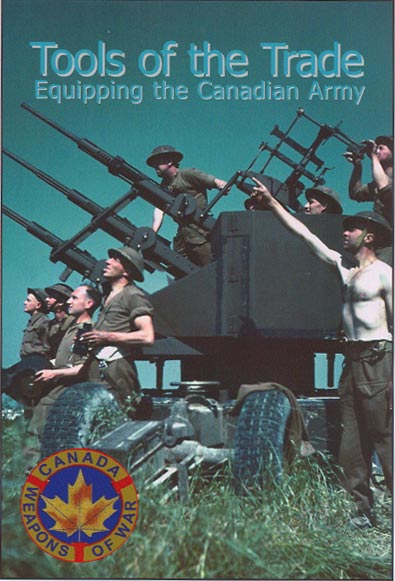Tools of the Trade: Equipping the
Canadian Army
by Doug Knight with additional
material by Clive M. Law

Service Publications, PO Box 33071, Ottawa, Ontario, Canada K2C 3Y9 (http://www.servicepub.com);
128 pp., 2005; price CDN $29.95
(ISBN 1-894581-23-7)
Advantages: sums up the entire Canadian military equipment used during
WWII in one neat volume; should be a standard for museum guide books
Disadvantages: photos and drawings of little use to modelers; some errors
and goofs in text and photo identification
Rating: Highly Recommended
Recommendation: for all Canadian military fans and WWII buffs
One of the uglier sides of empire has been the general treatment that
the Commonwealth nations, especially Canada and Australia, received at
the hands of Britain in regard to the operations of their native contingents
during WWI and WWII. Many Canadians and Australians to this day will not
forget (and in some cases forgive) Britain for the senseless loss of life
among their troops during the First World War in places such as Vimy Ridge
and Gallipoli, or the loss of more in the Second World War at Dieppe and
Crete.
This book highlights the measures taken during WWII by Britain to provide
equipment to its Commonwealth brethren and how poorly they were really
served by the "Mother Country." In 1940, Canada, like its US
neighbor, began to gear up for full-scale war. Canada at that time enjoyed
many of the same advantages as the US, namely being located too far from
most enemy or prospective enemy nations to suffer damage to their infrastructure,
most importantly industry. Canada had many factories which were either
satellites of US companies or affiliated with them, most notably Ford
and Chevrolet/GM Canada.
When Canada began to gear up, they also immediately began to mobilize
and send troops to England to defend against the Germans. But their first
unit, the 1st Canadian Infantry Division, arrived in the UK short of most
material and found that the British Army was also woefully short, and
did not have anything to share. Many WWI weapons were dug out of mothballs,
such as the SMLE Mark III and Ross rifles. Even then it was difficult
to get supplies to the troops.
The worst problem appeared to be the arcane method of allocation set
up by Britain. Even after the US and UK signed the Lend-Lease agreements,
the UK had final say on allocation of weapons and equipment, and picked
which units were equipped and in what order. One problem appears to have
been a British Purchasing Commission problem that today would be called
NIH – "not invented here" as they were iffy as to the
ability of the US and Canada to build equipment to British standards.
Things were at times nearly comical in a "Keystone Kops" vein.
The Canadian 1st Infantry Division was rushed to France in early June
1940, only to be turned around and sent back to England during Dunkirk
but minus all of the heavy weapons and kit they had painfully managed
to accumulate. They also found themselves low on the priority list for
replacement items; as a point of fact, even though they had been stripped
out by Dunkirk and were missing everything larger than small arms. the
newly-arrived Canadian 2nd Infantry Division (which supplied the troops
used at Dieppe in 1942) got higher priority for supply.
Things were always problematical. One fly in the ointment was the fact
that the Canadian CMHQ wanted its troops to be at least partially fitted
out with Canadian-produced material, which became difficult with the British
setting the allocation priorities for supply. There were literally cases
of hundreds of Ford and Chevrolet CMP trucks coming in to the UK –
only to go to either British units or the Middle East and the Canadian
units being stuck with whatever prewar vehicles they could scrounge up,
such as the Beaverette armored reconnaissance car.
In the end the Canadians fielded five full divisions (1st, 2nd and 3rd
Infantry, 4th and 5th Armoured) plus corps troops and other separate formations.
Their equipment was generally British pattern with a few Canadian touches
– mostly the superior Ford and Chevrolet trucks from Canada as well
as the best Commonwealth-produced SP gun of the war, the Sexton, which
combined the chassis of the Canadian Ram cruiser tank with the 25-pounder.
This book is a handy book of what the Canadians did get to use in the
Second World War, and from how and where it was obtained. The text is
very readable, and most of the information is quite useful.
Modelers will be disappointed as there is little for them, however,
as most items are only covered in passing and there are no plans or colors
discussed.
I have heard from other reviewers that there are some errors in the text
regarding numbers of items such as Crusader tanks, I do not have good
sources to check this out. There is at least one glaring error in photograph
identification: on page 33 is a weapon identified as a Vickers "K"
type machine gun; it is not, as it is a stripped down American Lewis gun
like those used in WWI aircraft mounts without the cooling fins or barrel
jacket.
Overall, those are quibbles, as the amount of information presented
is large and the coverage is very good. The Canadian War Museum in Ottawa
could do worse than to offer this book as a guide to WWII Canadian forces,
as it would be hard to beat.
Thanks to Clive Law of Service Publications for the review copy.
Cookie Sewell
|